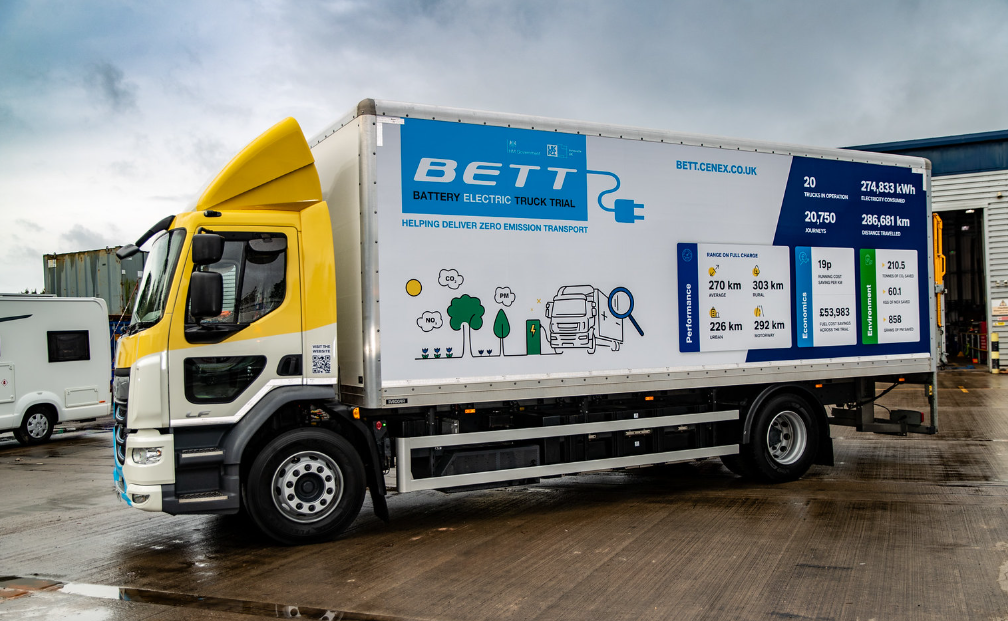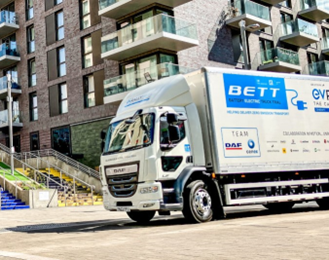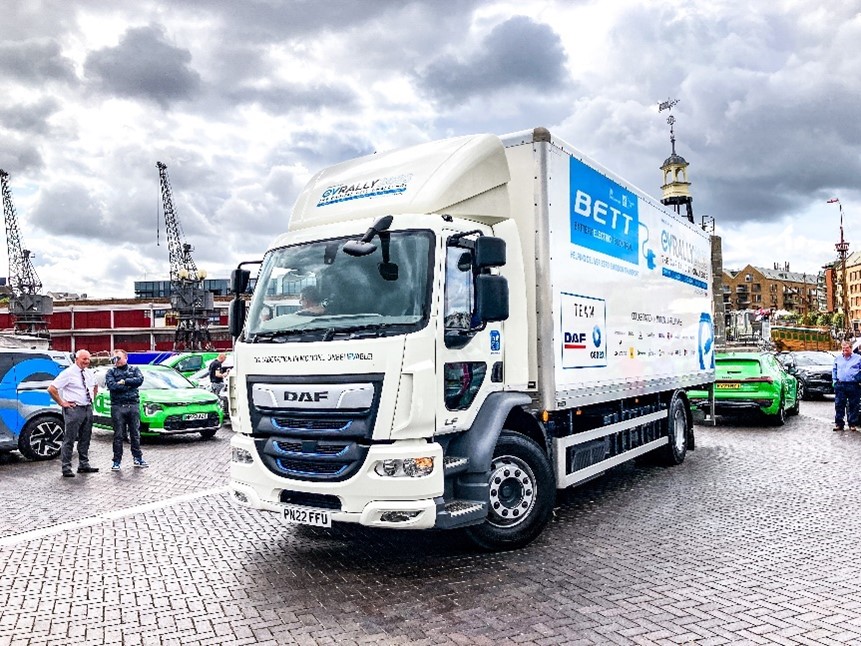
- Category:
- News
BETT: The Last Stop
The BETT (Battery Electric Truck Trial) has successfully concluded, providing an extensive and informative learning experience. The trial has generated a wealth of insights and data that can be found on the project website. The recently published final dissemination report comprehensively outlines the results and conclusions drawn from the trial, shedding light on the performance, efficiency, and feasibility of battery electric trucks. This report is an invaluable resource for anyone interested in the future of sustainable transport and the role of electric vehicles in it. View the final report here.
It all started in June 2021, when DAF was awarded funding from Innovate UK to commence an 18-month deployment of 20 electric trucks between April 2022 and September 2023. Decarbonising heavy goods vehicles (HGVs) is challenging due to the high mileage and weight of these vehicles. Therefore, to start tackling these challenges, the BETT project has created an early evidence-based platform to support HGV fleets on their journey to Net Zero.
Throughout the trial, Cenex provided DAF Trucks with specialist support in the areas of independent trial analysis and dissemination, generating evidence to show fleet operators that electric trucks can cover real-world operations. The trial outputs can be used to help fleets understand the best way to implement electric vehicles and charging and inform on barriers to adoption.
Telemetry loggers were installed to enable Cenex to collect data consisting of around 75 signals from each vehicle. This data was then used to generate and update a live feed of vehicle statistics on the BETT portal, which sat alongside other outputs of the trial including in-depth reports on trial learnings, general guidance on electric HGVs, and electric fleet planning tools.
The trucks on trial were DAF Electric LF’s, a rigid 19-tonne battery electric truck equipped with a 250 kWh battery, which is the predecessor to the recently launched DAF XB electric truck. The trialled trucks have a nominal range of up to 280 km on each battery charge and can be rapid charged at 150 kW. The nine participating fleets were a mix of councils, NHS-associated organisations, and public purchasing organisations.
Cenex has vast experience collaborating with fleets and technology developers to independently and impartially evaluate innovative low emission transport solutions. Our in-house analysis and modelling software coupled with our low emission vehicle expertise enabled the extraction of useful insights from the extensive telemetry dataset.
The average real-world rage during the trial was 270 km (equivalent to 1.08 km/kWh), varying between 225 km in urban driving (0.9 km/kWh) and 300 km in rural conditions (1.2 km/kWh). Regenerative braking was particularly helpful under urban and rural driving conditions, with 26% and 22% of the energy being recovered back into the battery, respectively.
Ambient temperature was a very important factor that affected the range, with an observed reduction of around 30% in winter compared to summer. However, a reduction in fuel efficiency would also be expected in diesel vehicles during colder temperatures. Some of the range reduction was due to increased consumption of energy for cab heating and for warming the temperature-controlled cargo bodies, which were the main ancillary loads.
The payload was also a significant factor in energy consumption, but its impact depended on drive cycle. High payloads in urban driving used 30% more energy than low payloads due to frequent accelerations and decelerations, while high payloads in motorway driving used only 10% more energy because of the more consistent speed.
Cenex’s data collection also included interviews with fleet managers and surveys completed by the vehicle drivers, both before and at the end of the trial. This enabled the capture of first hand impressions of the end users of the electric trucks and chargepoints, which complemented and validated the quantitative numerical data with valuable qualitative insights.
Fleet managers felt that the overall experience with BETT vehicles was positive, with clear operational and cost benefits and a reduced environmental impact. Compared to the start of the trial, fleet managers became progressively more confident with the range of the vehicles and began assigning them to longer routes. At the end of the trial, vehicle drivers had a more positive outlook on factors such as acceleration, steep incline performance, ease of recharging, manoeuvrability, and range, compared to the start.
Failures of chargepoints sometimes resulted in the unavailability of vehicles when required. Technical issues with the vehicles were occasionally exacerbated by the scarcity of electric truck technicians, a problem likely to be resolved with greater market penetration. Furthermore, the absence of public charging infrastructure for HGVs imposes a constraint on longer routes.
Cenex also created a total cost of ownership (TCO) model to demonstrate the relative importance of 21 operational, policy and external factors on the finances of operating an electric HGV.
The TCO model showed that if electric trucks were frequently recharged at public chargepoints, their high electricity tariffs would yield an additional annual cost of around £10,000 per vehicle compared to diesel, while the additional annual cost would shrink to £2,000 if fleets charged only at the depot. Even though maintenance costs and taxes are smaller for the electric vehicle compared to diesel, the larger capital cost and the higher fuel costs (especially when charging at public chargers) are the reasons for the higher costs. The TCO model allows exploration of scenarios, some of which do provide significant savings, such as cheap electricity at the depot, highly efficient electric powertrains compared to diesel, or a higher manufacturing maturity of electric trucks.
Cenex also performed a life cycle assessment (LCA) to understand the environmental impact over the entire life of a truck from the production of raw materials through to manufacturing, regular use, and end-of-life.
The headline result from this LCA is that emissions are highly dependent on the source of the electricity. Using electricity from the baseline UK grid mix produces less than half the emissions of a diesel comparator truck, while an almost 90% reduction is possible with very low carbon Danish electricity. However, a grid that is heavily dependent on coal could see a 13% increase in diesel use-phase emissions. Despite the higher production-phase emission of the electric truck, the high distance typically travelled by HGVs means savings from the use phase dominate over the life of the truck. With the baseline UK grid mix, environmental payback is possible within 60,000 km or just over a year of typical use.
We are eager to see what the future holds for electric trucks in the UK and beyond. The recently launched government-funded demonstrators for larger zero-emission tractor unit HGVs and their charging infrastructure are very welcome. These demonstrators will include battery electric trucks, whose performance and acceptance within fleets will be closely monitored by the industry, including Cenex.


